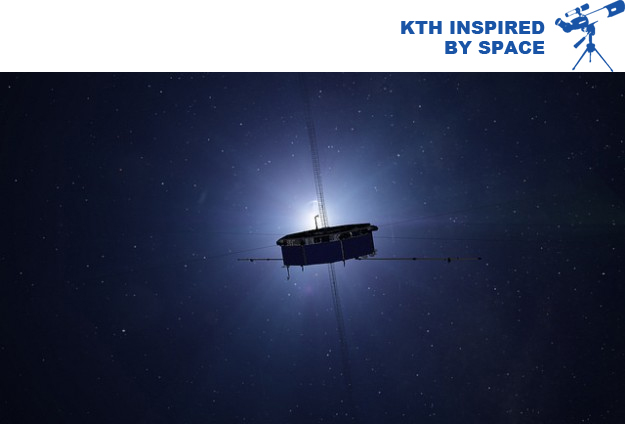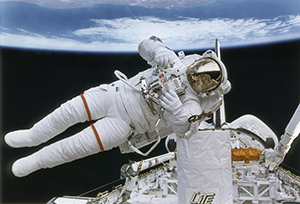Probes pick up where space exploration leaves off

Inside a small suite of offices at the department of Plasma Physics at KTH Royal Institute of Technology, researchers are picking up where space exploration leaves off. The object of their work is to understand the fundamental plasma-physics process that connects and disconnects magnetic fields in space.
What causes magnetic fields in space to connect and disconnect, releasing explosions of energy? This phenomenon, which causes mass ejections on the sun and the aurora borealis on Earth, is the subject of NASA's Magnetospheric Multiscale (MMS) mission. One of the key roles of this ambitious mission is being carried out right here in Stockholm.
Per-Arne Lindqvist and Göran Marklund are two of the physicists at KTH who are involved in the MMS project. Their laboratory is Earth's own magnetosphere, where equipment designed and engineered at KTH has just been deployed aboard four spacecraft that zoom in tetrahedral formation around the planet. Their elliptical orbit ranges between 1,300 km and 70,200 km from Earth (or 1/5 of the distance to the moon).
"We have reached that point where we have done missions to most of the planets in our solar system," Lindqvist says. "We've done all the firsts, and now these types of missions are needed to produce high-time-resolution, high-spatial-resolution data so you can really refine the theories and pinpoint exactly what is going on in space.
"The first missions confirmed the magnetic fields in our solar system; now we can really find out how they work."

Lindqvist has just returned from the MMS science operations control centre at University of Colorado, in Boulder, where he was in charge of the deployment of four 60m-long wire booms aboard each of the four spacecraft that were launched in March. Each boom carries an electric field probe that takes high resolution measurements of plasma during the process of reconnection, which is set off when solar winds slam into the magnetosphere, a protective magnetic bubble that surrounds the Earth.
Lindqvist and a researcher from Uppsala University, Yuri Khotyaintsev, together performed tests and optimizations on the instruments during the summer, and now the spacecraft are sending the first batches of scientific data down to Earth.
"The data look very good," Lindqvist says. While the mission involves basic research, there is a practical side to using the findings. Predicting reconnection events could be useful since the explosions of energy they release affect electronics aboard such things as satellites and the International Space Station — not to mention the people who work in space.
Magnetic reconnection occurs universally in plasmas, the electrically-conducting mixes of positively and negatively charged particles that make up an estimated 99 percent of the observable universe. It is the cause of what we call, “space weather.” But that's not all. Eruptive solar flares, coronal mass ejections (CMEs), geomagnetic storms, and magnetospheric substorms all involve the release, through reconnection, of energy stored in magnetic fields.
Reconnection can accelerate particles up to nearly the speed of light. By studying reconnection near Earth, Lindqvist says that MMS will help scientists understand reconnection in the atmosphere of the sun and other stars, in the vicinity of black holes and neutron stars, and at the boundary between our solar system’s heliosphere and interstellar space.
Marklund and Lindqvist say missions such as the MMS are a step forward as science completes a long period of space exploration. "Magnetic fields play an important role for understanding astrophysical phenomena," Marklund says. "But this hasn't been taken into account until the last decade.
"We have pinpointed several universal processes not just occurring in the Earth's magnetosphere, but which are also behind the process where energy is ejected from the sun," Marklund says. "Reconnection is also associated with much larger astrophysical objects — such as astrophysical jets — to explain how particles are accelerated in space by electric fields and the energy conversion process. "
The MMS project is an extraordinary case of Swedish and American cooperation on space exploration and research. The probes were engineered through cooperation with the University of New Hampshire, and one of the rare instances where NASA has deployed instruments not made in the US.
Marklund will speak about the project for a special audience of American officials and space sector representatives during an event organized by the Swedish National Space Board, and held at the Swedish Embassy in Washington, DC, on October 6, to mark Swedish-US cooperation in space technology, exploration and research
The week before this, early results from the MMS mission will be presented at the “Chapman Conference on Magnetospheric Dynamics” in Fairbanks, Alaska, which is arranged by the American Geophysical Union. Marklund is a member of the AGU scientific committee, and one of the invited speakers.
Lindqvist will also give a short talk about the MMS mission during the Association of Space Explorers annual congress being held at KTH next week.
David Callahan

